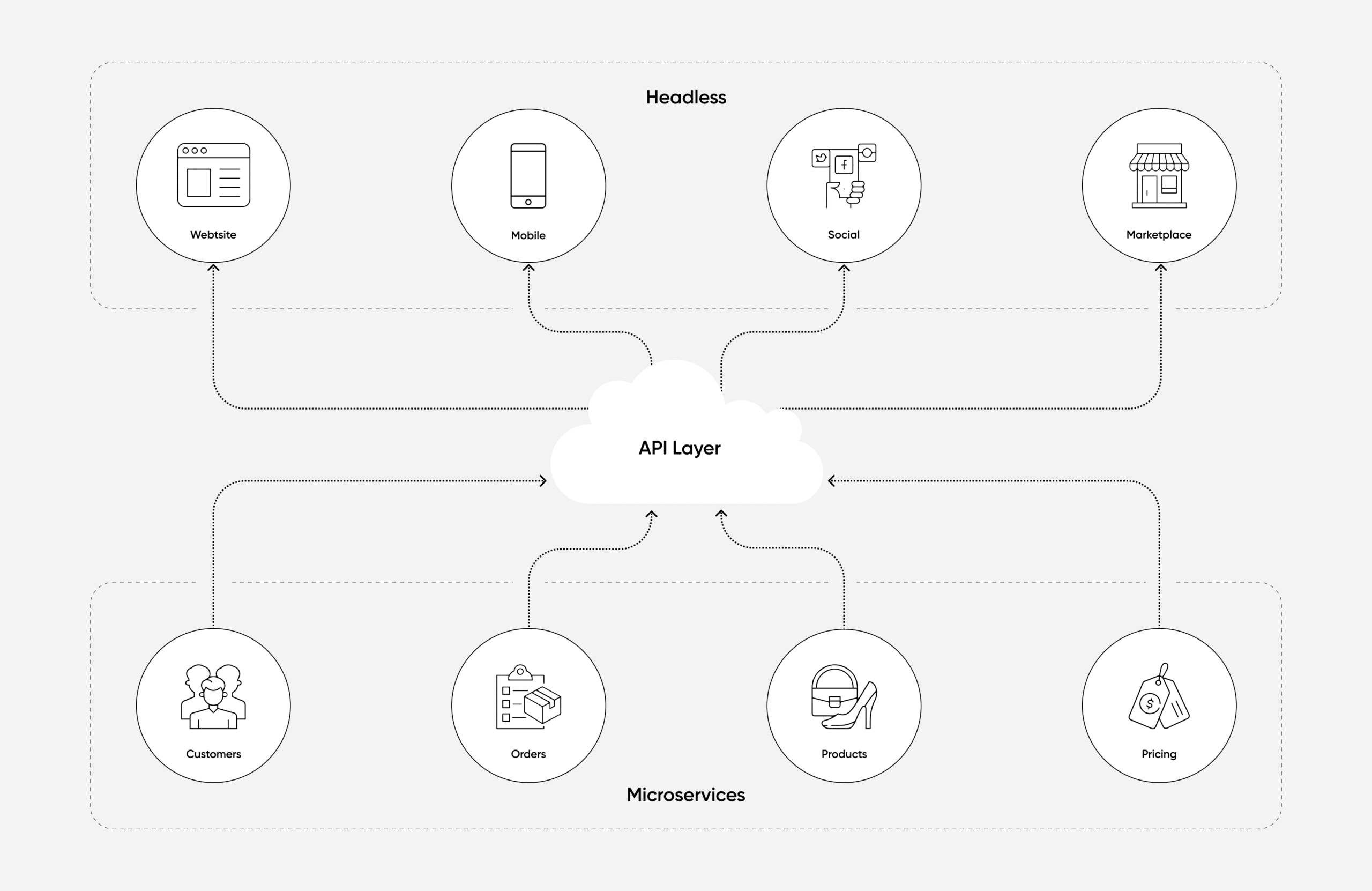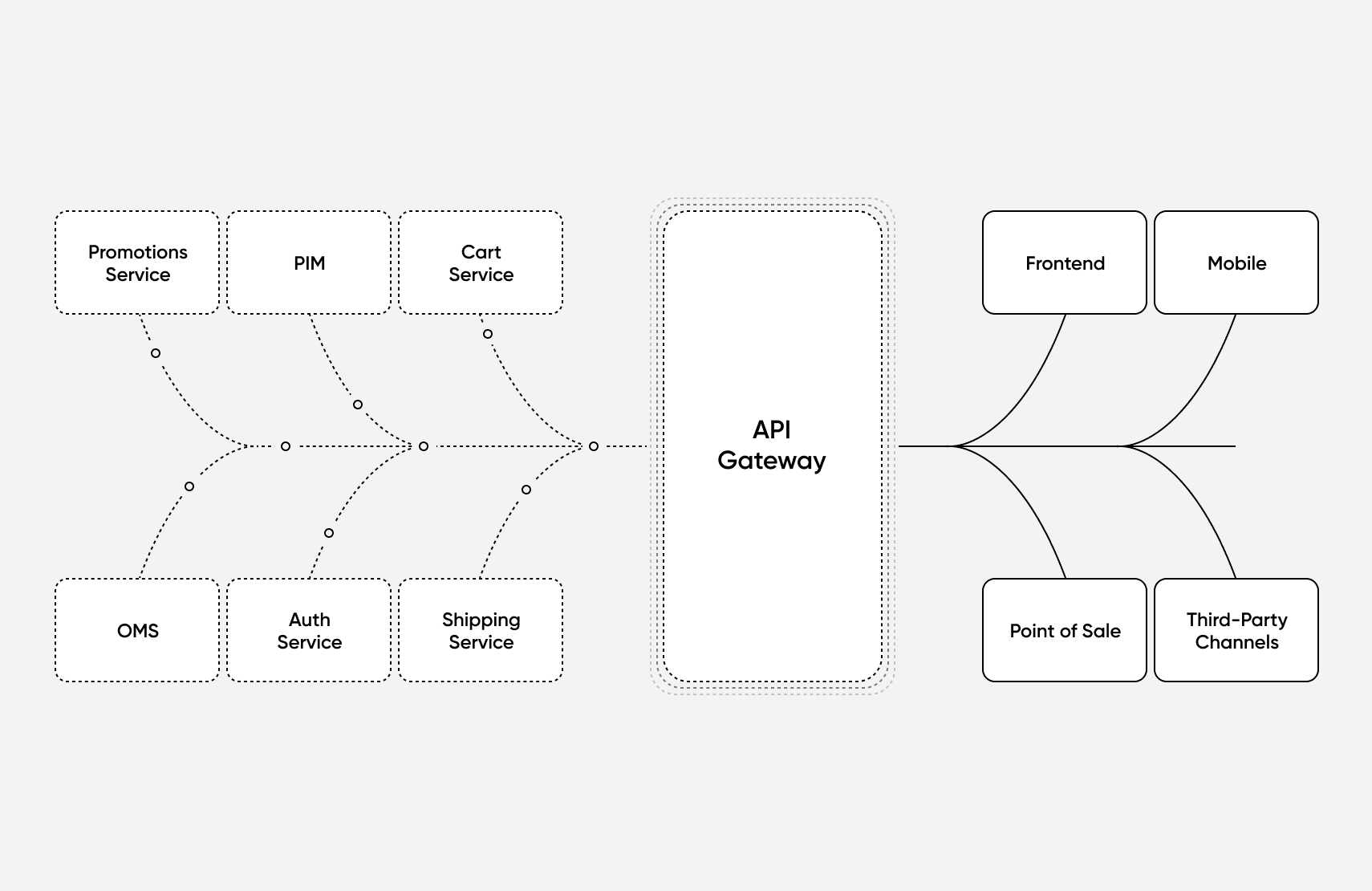What Is MACH Architecture?

MACH architecture provides a future-proof solution for online retailers as it allows businesses to quickly adapt to any emerging technologies.
Microservices provide stand-alone applications designed to perform a single function. Because they can be changed independently they allow for seamless upgrades and higher fault tolerance.
Headless architecture decouples the frontend and backend of your e-commerce platform, enabling omnichannel selling and more customized shopping experiences.
APIs serve as a software intermediary that enables the different microservice applications and decoupled headless components to talk to each other as all data exchanges between applications is done via API.
[toc-embed headline=”MACH Architecture Definition”]
MACH Architecture Definition
MACH architecture is a modern infrastructure for building e-commerce platforms; the acronym stands for Microservices-based, API-first, Cloud-native, and Headless.
[toc-embed headline=”Overview of MACH Architecture”]
Overview of MACH Architecture
MACH architecture provides online retailers with a way to deliver seamless shopping experiences to their customers across all devices. The idea is based on four principles that differentiate it from the traditional e-commerce setup.
- Microservices-based: Stand-alone applications that are independently developed, deployed, and managed. Microservices are designed to perform a single function like product search, product reviews, checkout, wishlists, and more.
- API-first: All pieces of the system are connected through an application programming interface (API), making it possible for otherwise separate components to operate together.
- Cloud-native: All software development and delivery are based in the cloud. Cloud hosting offers a scalable infrastructure and all technology is automatically updated by the vendor.
- Headless: A headless setup decouples the frontend and backend of your e-commerce solution. This provides the ability to create custom frontend experiences and to use a unique user interface for every channel.
All these components work together to provide a flexible, scalable, and agile commerce solution. MACH technology enables online retailers to take a best-of-breed approach when building an e-commerce platform.
Instead of having to rely on a single system to handle everything, MACH architecture allows you to pick and choose the best available technology for each specific area of functionality. You no longer need to settle for ineffective components just because they are coupled to a system as a whole.
Flexible customizations
In the rapidly evolving world of e-commerce, it’s important to be able to adapt to changes in customer behavior swiftly. MACH architecture provides a flexible and fluid solution that can easily be adjusted as needed. Whether you need to add a rebranded ordering experience, or some slight functionality for an upcoming promotion, MACH architecture allows you to make changes without disrupting your business.
With a traditional all-in-one e-commerce solution, the frontend and backend processes are combined into a single system. Because they are tethered to each other, a single issue or change in code could end up breaking the entire system. Using microservices divides the applications into a set of smaller, specialized components, giving developers the ability to work on different pieces in isolation without affecting the system as a whole.
A solution to replatforming
Technology is changing so fast that many business tools become outdated almost as soon as they are introduced. Because of their modular design, MACH technology provides a way for businesses to stay in front of any emerging trends.
Switching to a MACH setup is the last replatforming project a business will need to undertake. With this structure companies can choose from the best available tools, giving them the ability to continuously add and replace solutions to improve their entire ecosystem as needed.
[toc-embed headline=”How MACH Architecture Works”]
How MACH Architecture Works
MACH architecture works by taking a massive block of components and breaking them down into smaller, interconnected pieces that are able to work more effectively in isolation. It begins with the numerous pieces needed to create a feature-rich interface for online shoppers.
With a traditional e-commerce platform, all the features of the storefront function under a single instance with a single database. With microservices, these services are self-contained and have their own database. This means there could be a different app for customer support, product management, and the shopping cart. The microservices have their own load balancer and execution environment to perform their functionalities while simultaneously capturing data in their own databases.
Microservices use service discovery to find the proper route of communication between each component. They then communicate with each other using an API. Once the microservices have communicated with each other, they deploy static content to a cloud-based service that will deliver the content to clients via content delivery networks (CDNs).
Microservices help to improve the scalability of e-commerce solutions. As the entire system becomes modular, each microservice can be individually scaled through on-demand auto-scaling.
With a headless commerce setup, the API is used to pull information to any device including apps, smart appliances, wearable tech, and social networks. When a customer makes a purchase, the API handles communication between payment processing, inventory management, and the CRM to ensure all data is up to date.
[toc-embed headline=”Examples of MACH Architecture”]
Examples of MACH Architecture
Amazon
Amazon is the perfect example of an online retailer following the MACH architecture. The company has been using microservices since 2006 and now has thousands of microservices serving as the components for hundreds of user interfaces.
Amazon is also a leader in the headless commerce space having created the Amazon Echo IoT device and now leading the way with Dash ordering. They make the most of a decoupled frontend and backend by seamlessly deploying code every 11.7 seconds without interrupting their services.
Uber
Uber is another example of a company that utilizes MACH technology. Switching its app from a monolithic platform to a MACH architecture has enabled the company to become the world’s largest ridesharing company.
On a monolithic platform, all the components are interconnected; making a single change affects the entire app. However, software that’s built on microservices consists of independent services, so when developers update the app, other components remain unaffected. Thus, a MACH architecture lets Uber continuously make improvements to meet customer needs.
Tech advocate and writer @ fabric.

